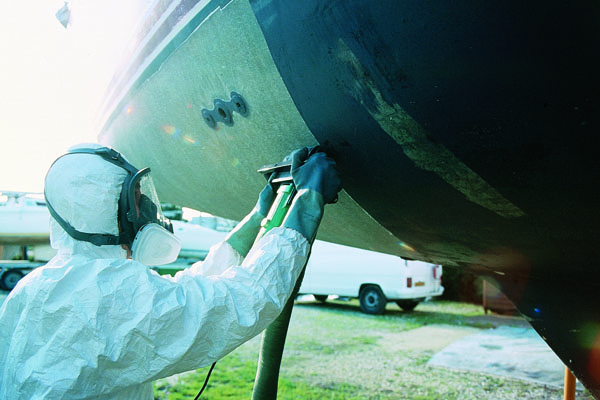The bête noire of polyester
When should you worry?
On a boat that is a few years old, small blisters do not pose a danger. The blisters are, though synonymous with osmosis. One must intervene. The prevention products that are used for processing small pinheads, or even before they occur though, are often more dangerous than doing nothing. If one applies an impermeable product on a not perfectly dry boat, it can actually accelerate osmosis. On a boat with osmosis (large blisters,) action has to be taken. It is a major
operation that requires peeling the gelcoat and controlled drying of the hull which can take months. When the hull is completely dry apply an epoxy resin based product.
operation that requires peeling the gelcoat and controlled drying of the hull which can take months. When the hull is completely dry apply an epoxy resin based product.
Understanding osmosis
Osmosis is basically water penetrating the polyester. This water destroys the resin.The boat becomes soft and is likely to decompose. Osmosis is directly related to the components that go into the manufacture of a polyester hull: the acid and the alcohol. This mixture which is added to the fibreglass changes from viscous to solid with the help of a catalyser. Upon completion of this mixture, sometimes strands of glass fibers are mixed into the resin without being fully impregnated with the catalyst or the chemical reaction is incomplete. This creates small cavities in the structure of the hull, filled with a highly concentrated liquid, composed of acid and impurities. This liquid is neutral unless it is brought into contact with water. Natural osmosis is the imbalance between two liquids of different concentrations separated by a semipermeable membrane. The least concentrated liquid passes through the membrane to go to the most concentrated. On a boat we have a very concentrated liquid, water, another concentrated liquid within the boat’s structure, the two seperated by a semi-permeable membrane: the gelcoat. The concentrated liquid contained in the hull, in contact with water that has passed through the gelcoat, undergoes a chemical reaction (hydrolysis) and is transformed into acetic acid, whilst increasing in volume. With a modern good quality,waterproof gelcoat, water, which has penetrated the gelcoat by osmosis and which, on reaction with the liquid contained by the polyester is likewise converted into acetic acid, cannot leave. This increases the volume appearing as blisters. The fact the blisters are filled with acetic acid accounts for their distinctive vinegary odour (it comes out when pierced.) This also explains why, with an old porous gelcoat, there are no blisters, hydrolysis still occurs, the acid is still created but, instead of causing blisters, it passes back through the gelcoat.
Osmosis treatment
Preventing osmosis consists of creating a waterproof barrier between the resin and the water. For this we use an epoxy resin. On a new boat, it is possible to provide this treatment before the first launch. On a boat that has already sailed, ensure that the hull is dry, to be sure not to trap moisture behind the epoxy barrier. On a boat which contains moisture, it is necessary to remove the gelcoat (the best way is planing), dry the boat (sometimes several months) and then redo it including the epoxy barrier.

